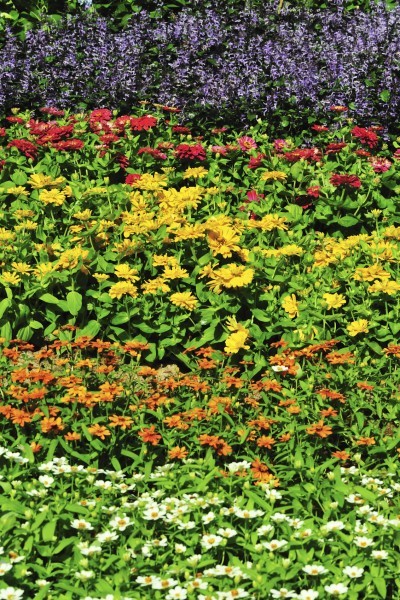






Layering is an essential part of seasoning cooking. Adding a subtle layer of flavor to each item you add to the pot seasons it and enhances the whole dish without an overwhelming final flavor. Creating a layered garden has a similar purpose. It soothes the eye while enhancing other aspects of the garden. Planting a garden in layers considers both vertical and horizontal eye appeal but also the aspect in which we view the area and seasonal interest. Learn how to build a layered garden with a brief tutorial on the process and its components.
Layered garden ideas are not new concepts but have been around as long as mankind has cultivated garden spaces for pleasure and productivity. The process takes some planning and time as the garden fills in, but the effect is unique at all times of the year and takes advantage of each plant’s attributes, creating a rich artwork out of the landscape. To start creating a layered garden, consider your soil, lighting, needs, and picture the effect you wish to present.
The first thing to consider is access and borders. This “hardscaping” encompasses walls, fences, paths, buildings and other access and structural constructions. Utilizing hardscape features to accent the natural aspects of the garden is part of vertical layering.
This may mean having a clematis vine creep up the side of your home or a rose trellis creating a border between the ornamental and vegetable areas of the landscape. It also helps to envision the actual areas to be planted so you can consider what type of installations you require for your vision.
Trees and bushes are the next layer and are appealing in groups rather than sentry-like rows. Next, we consider the medium sized and smaller plants to go into each bed. Each plant has unique form and tells a different story as the season progresses.
After a little planning to decide on the look you want for each area of the landscape, you need to consider how to install the specimens you have chosen. Garden layering with plants must take into consideration size, seasonality, form and function. For instance, a perennial garden can have 5-foot-tall plants, and plants as low as woolly thyme and anything in between, but it would be profitless to plant the thyme behind some Joe Pye weed where the access to the view would prohibit spying the cuddly little herbs as they sprawl across the ground.
Planting a garden in layers will ensure that the highest plants are at the farthest eye point of the garden with medium sized in the middle and the lowest growing at the front. Layered garden ideas such as shade gardens, perennial beds, borders and even xeriscape landscape areas can be done using this approach of vertical layering.
When we are considering garden layering with plants, it is important to look at the horizontal view. Successfully achieving horizontal layering gives a garden bed a mature, finished appearance. It all depends upon planting lower plants so that they will touch each other when they are mature. This promotes a sea of rolling color and texture that is easy on the eye and adds an artistic aspect to the garden.
While you are at it, look at what plants will have winter appeal and don’t hide these behind large plants that will cover their unique beauty. Some of these might be contorted hazel, red twig dogwood or Edgeworthia with its bare branches adorned with tasseled blooms.
Once you have a sense of the plants you want and the layering approach you wish to take, repeat patterns, colors, forms and textures throughout the landscape to create unique patterns in the landscape.
Companion Planting in Your Garden
Tips for Creating Garden Design Ideas
Get Your Hands Dirty by Planting a Garden
Herb Garden Designs : Planning Before Planting.
Toxic Garden Plants – Learn About Poisonous Garden Plants To Look Out For
What Is A Native Plant: Learn About Native Plant Benefits In The Garden
Copyright © www.100flowers.win Botanic Garden All Rights Reserved